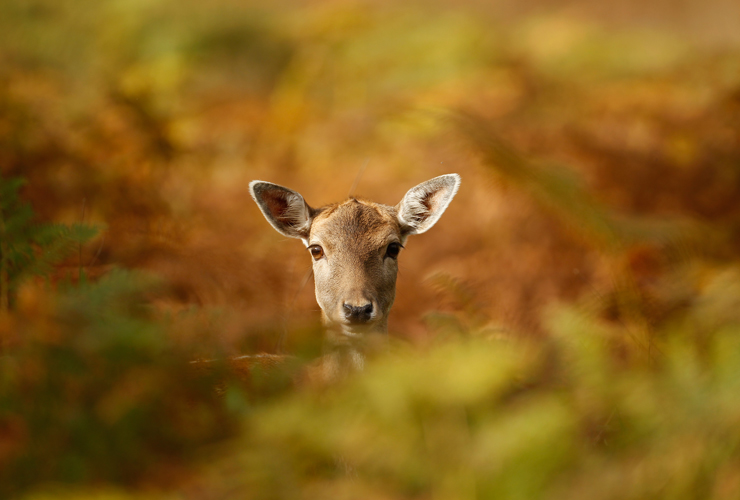Does ‘zombie deer disease’ pose a threat to humans?
Scientists say people who eat the infected meat may be at risk of condition similar to BSE

A new condition similar to “mad cow disease” is spreading quickly among animals in North America - and scientists fear it could cross over and infect humans.
Chronic wasting disease (CWD) - dubbed “zombie deer disease” - has infected deer, elk and moose across 24 US states and two Canadian provinces.
A red deer farm near Ontario in Canada has had 11 confirmed cases.
The Week
Escape your echo chamber. Get the facts behind the news, plus analysis from multiple perspectives.

Sign up for The Week's Free Newsletters
From our morning news briefing to a weekly Good News Newsletter, get the best of The Week delivered directly to your inbox.
From our morning news briefing to a weekly Good News Newsletter, get the best of The Week delivered directly to your inbox.
Symptoms of the disease, which starts in the tissues of the brain and spinal cord, include “weight loss, clumsiness, listlessness, excessive thirst and drooling”, says The Daily Beast.
Animals “often exhibit bursts of aggression before collapsing and, eventually, dying”, the news site adds.
CWD currently “appears limited to deer, moose, and elk”, says Popular Science magazine. But University of Minnesota researchers warned local lawmakers last week that they need to take immediate action to prevent the potential spread to humans.
Michael Osterholm, director of the university’s Center for Infectious Disease Research and Prevention, compared the situation to the epidemic of bovine spongiform encephalopathy (BSE), or mad cow disease, that hit the UK in the 1990s, when there was initial uncertainty over whether the lethal condition could spread to humans.
A free daily email with the biggest news stories of the day – and the best features from TheWeek.com
At least 156 people in Britain died after contracting BSE, which like CWD is a so-called prion disease, known as transmissible spongiform encephalopathies.
Osterholm said: “It is my best professional judgement that it is probable that human cases of CWD associated with the consumption of contaminated meat will be documented in the years ahead. It is possible that number of human cases will be substantial and will not be isolated events.”
Up to 15,000 infected animals are eaten each year, a number that could rise by 20% annually, he added.
Scientists “can’t say for sure that CWD will cross over and infect humans”, says USA Today. But according to Osterholm, as time goes on and more infected meat is consumed, the likelihood increases.
Although there is still no concrete evidence that the disease can cross the species boundary into humans, the World Health Organization believes it is possible.
“It's like a throw at the genetic roulette table,” Osterholm said. “If Stephen King could write an infectious disease novel, he’d write it about prions.”
Researchers are hoping to develop an affordable new test that hunters can use to see if the meat of the animals they kill is infected.
In the meantime, “if you hunt (or eat meat that others have hunted for) in one of the infected areas, the US Centers for Disease Control doesn’t necessarily say you can’t eat your venison”, says Popular Science.
But the experts do recommend exercising caution with any animals that look sick or are acting strangely, and to minimise touching the organs as much as possible, especially the brain and spinal cord.
-
 Is Trump deliberately redacting Epstein files to shield himself?
Is Trump deliberately redacting Epstein files to shield himself?Today’s Big Question Removal of image from publicly released documents prompts accusations of political interference by justice department
-
 Ashes to ashes, ducks to ducks: the end of Bazball?
Ashes to ashes, ducks to ducks: the end of Bazball?Talking Point Swashbuckling philosophy of England men’s cricket team ‘that once carried all along with it has become divisive and polarising’
-
 The strangely resilient phenomenon of stowaways on planes
The strangely resilient phenomenon of stowaways on planesIn The Spotlight Lapses in security are still allowing passengers to board flights without tickets or passports
-
 ‘Lumpy skin’ protests intensify across France as farmers fight cull
‘Lumpy skin’ protests intensify across France as farmers fight cullIN THE SPOTLIGHT A bovine outbreak coupled with ongoing governmental frustrations is causing major problems for French civil society
-
 How Bulgaria’s government fell amid mass protests
How Bulgaria’s government fell amid mass protestsThe Explainer The country’s prime minister resigned as part of the fallout
-
 Femicide: Italy’s newest crime
Femicide: Italy’s newest crimeThe Explainer Landmark law to criminalise murder of a woman as an ‘act of hatred’ or ‘subjugation’ but critics say Italy is still deeply patriarchal
-
 Brazil’s Bolsonaro behind bars after appeals run out
Brazil’s Bolsonaro behind bars after appeals run outSpeed Read He will serve 27 years in prison
-
 Americans traveling abroad face renewed criticism in the Trump era
Americans traveling abroad face renewed criticism in the Trump eraThe Explainer Some of Trump’s behavior has Americans being questioned
-
 Nigeria confused by Trump invasion threat
Nigeria confused by Trump invasion threatSpeed Read Trump has claimed the country is persecuting Christians
-
 Sanae Takaichi: Japan’s Iron Lady set to be the country’s first woman prime minister
Sanae Takaichi: Japan’s Iron Lady set to be the country’s first woman prime ministerIn the Spotlight Takaichi is a member of Japan’s conservative, nationalist Liberal Democratic Party
-
 Russia is ‘helping China’ prepare for an invasion of Taiwan
Russia is ‘helping China’ prepare for an invasion of TaiwanIn the Spotlight Russia is reportedly allowing China access to military training